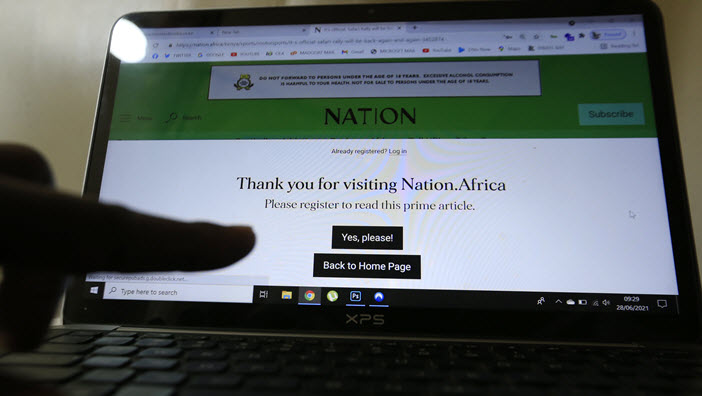In Kenya’s media industry, the paywall – a digital system that allows only readers who have subscribed by paying a certain amount of money to access news articles and stories on a website – is a new business model and a new source of revenue. The paywall has been in existence since 1996, when the Wall Street Journal (US) first tried it out.
Other news websites worldwide have joined in over the last two decades, but the New York Times seems to have found a working and profitable model of charging readers on their website. The latest subscription numbers from the New York Times are not public. However, this might shed some light on just how well they cracked the paywall success code: In the first quarter of 2020 (January to March), the New York Times boasted over 5 million subscribers. Two months later, the company announced that it had amassed one million more new subscribers and now had over 6 million.
When revenue from traditional advertising is going down, revenue from the New York Times’ subscription is at an all-time high; easily the best in the world. The company appears to be in its league when it comes to attracting new subscribers. It has mastered the art of producing quality journalistic content and consistently uploading it on its platform. How to retain subscribers, layout content, and track audience consumption habits to know what compelling content to keep churning out and keep the readers hooked.
Can The Standard and the Nation websites in Kenya and their newly instituted paywalls achieve the same success? “A large majority of our audience can still access the website for free. We do not require them to pay anything,” says Churchill Otieno, Managing Editor, Digital at Nation Media Group and President of Kenya Editor’s Guild.
“What we have is a hybrid paywall which allows people to read some content freely but requires them to register and pay to access certain specific content. It’s something that we keep working to improve every single day,” Churchill, who was instrumental in implementing the paywall system at Nation told the EAST Site.
Keeping up with the market trends
The Nation recently celebrated signing up its first 50,000 subscribers. Churchill says that the response from the audience is positive so far, and they are meeting their targets. They are keen on analyzing user data to understand market trends and serve their readers better. At the same time, they are aggressively driving registration.

But there has been one problem; the number of clicks on their website has dropped. “The drop in traffic is a natural behaviour within an audience pool in the short term whenever paywalls are introduced,” Churchill explained. He said this is especially true in a market that has not had paywalls before. “Initially, people are used to free-ranging, where they are able to come in and go however they like, and so when you begin introducing hurdles in their path, the natural thing is that instinctively a few of them will be discouraged from visiting the site,” Churchill added. “The trick is to provide compelling and unique content consistently, and they will be back on the platform.”
Reaction from Kenyans
On social media, Kenyans have been saying they do not think putting up a paywall is the right move. Others say they will never pay for website access. According to Churchill, however, any perceptive observer will quickly notice that this conversation is user-driven, that it is the users themselves initiating and sustaining that conversation. It’s curious why it has remained an issue of public interest 10 weeks after The Nation enacted the paywall system.
“This is a new ‘news’ habit within that audience, and for me, that’s important,” Churchill said. “We have a cohort of users that are resisting, but we also have another cohort of users that have embraced the paywall and have moved into habitual users of that paywall.”
For Churchill, the main challenge is to slowly but surely grow the numbers of those embracing the change while working with those pushing back. “Just to help clarify things to them, especially that a paywall is probably the purest choice of supporting journalism.”
Brian Okoth, News & Current Affairs Editor, Digital at Standard Group, shares Churchill’s positivity about the future of paywalls in the country.
“If in a week you can make half a million shillings, this is something most news websites don’t make in native advertising,” Brian told EAST Site. “This is to show how successful paywalls can be. Of course, ours is still a work in progress, and there are areas where we can do better.”
Brian believes that the Standard can achieve the New York Times type of success in Kenya. “It is all about context. You must understand the environment you work in,” Brian said, stressing that The New York Times understands their environment pretty well. Hence, they push social content and information to do with family, homes (human interest type of content) and politics. “The best example is how they covered Bill and Melinda Gates divorce. They understood the social and political implications of the divorce and decided to go big on it. It worked for them.”

Content Saturation
The Standard paywall, which is just a few months old, is not without challenges. Running premium content every day is not easy, according to Brian. There are days when everything is happening, and it is good news material. But then there are days when even after doing good follow up pieces, there is content saturation, and it becomes challenging to sell unless you have something new and spectacular to add. “This is the reason why we are here. It gives me excitement to find ways of ensuring that the curve does not fluctuate in terms of the quality of content.”
What about the Nation? Can it replicate New York Times success?
“Different markets, different realities and very many intervening factors,” Churchill explained. However, he also emphasised that his team remain resolute. “There is no going back. We are going to do what it takes, lots of lessons to be learnt, there will be lots of failures that we have to contend with but all that is expected and all that is planned for,” Churchill noted.
“I do not know if it will go the NYT way. Chances are it won’t. Chances are that there will be a totally different path because of the different set of intervening factors in our strategy,” Churchill Otieno of the Nation concluded.
Jane Godia, an editor, media trainer and Director at Women In News -Africa, is keen on how media practitioners are responding to such industry changes. She suggests that journalists must be open to learning and they must find a way of being in-step with developments and transformations taking place in their organisations.
“Digital transformation is one place where journalists need to be aligned or they will be left behind. At Women in News we are bringing this message home to our cohorts and are taking them through modules we have developed. They must develop skills that will enable them to stay on top of the changes taking place in the industry.”
But is the Kenyan public ready for the paywall, seeing as they are only used to free online content from multiple sources?
“A lot of sensitisation and awareness creation must be done,” says Godia, adding that media organisations will have to initiate adult public education on paywalls to make ardent readers of hard copies and free content understand that the world has changed.
“Some media houses may not make immediate profits as they anticipate. The change may not be instant but they must find a way of reassuring their readers and making them understand that paywall is cheaper than buying the hard copy and that one spends less in a month through the paywall than buying a hard copy.”
 Isaac Swila
Isaac SwilaReport by Aga Khan University’s Media Innovation Centre analyses the country’s millennials and digital natives’ media consumption habits.
For the media to flourish, and the society to have free flow of accurate and verifiable information, journalists, the drivers in the passing of information are expected to be well grounded in laws and the legal aspect pertaining to the job, writes Alfred Ganzo.
Pitching provides numerous opportunities for your new or existing business ideas to be discovered and realized; and as Simon Mtabazi writes, some startups have become billion-dollar companies due to efffevie pitches
The success you achieve with your media startup business will heavily rely on your reputation as a trustworthy company, and as Nandi Mwiyombella writes, it will also open a new window for customers and potential investors.
That’s why I think today is such a great space for us to sit back and reflect on the questions that could help us shape the kind of journalism that we want to see in our local and global community.
The report specifically analysed eight major variables which include: newsroom structure and resources, media ownership and business models, organisational capacity, innovation culture, journalism culture, financial trends and results, content quality and COVID-19.
Mudi, in her role as Media Council of Kenya regional coordinator in charge of Mombasa(covering the entire coastal region), has found herself at the forefront in advocating and fighting to protect journalists’ rights, culminating in her being awarded for her peace efforts in the run-up and during the 2022 general elections in Kenya.
The 2022 general elections have been mentally draining for journalists, some of whom have had to stay on the campaign trail for over a year. Others have had to toy with the tough call of managing teams in the newsroom. East Site’s Isaac Swila and political writer Rawlings Otieno recount their experiences
What role did social media influencers play in the election? What voice did they give in political discourses during and around the election period? And to what extent did political candidates involve the influencers in marketing their manifestos to sway votes in their favour? East Site writer Steven Omondi unpacks the details
The media industry is experiencing enormous transformation as new digital trends emerge. With the vast opportunities that the digital space offers, media owners and content producers must deliberately adapt to how the audience consumes content.
With the increased Digital Technology at the palm of just anybody; there are a lot of information that distort whether deliberately or not highlighting the need of robust Fact0checking as Asha D. Abinallah explains
Is there a danger in media personalities having a vibrant social media presence? Assuming they have a massive media following, should they self-regulate and filter what they post? And when they engage with followers, should their opinions be taken as personal, or does it represent the journalist’s media house? East Site writer Isaac Swila explores
Media stakeholders are raising concerns over the lack of gender-inclusive reporting in East African newsrooms. They want concerted efforts to ensure more female journalists get equal opportunities like their male counterparts.
The partnership will also ensure that local content is curated and distributed to better optimize the product and meet the needs of Kenyan online users.
The news industry is constantly changing, and in the last few years, User Generated Content (UGC) has become a ubiquitous feature in news sourcing and packaging. However, media houses and journalists need to establish verification and credibility safeguards to avoid the misinformation trap.
Reporting on elections is, for many journalists, an opportunity to establish themselves as reliable political reporters. But the task comes with certain risks, particularly in the East African sub-region.
Stakeholders are now calling for concerted efforts, better planning and preparations for journalists before they are sent out on the field to cover Kenya’s high-stakes August 9 General Elections.
East Africa’s media grapples with a myriad of challenges whenever general elections approach. Not only do editors struggle with balancing the competing political interests, at times at the altar of professionalism, but individual journalists pay dearly, many suffering attacks in the course of their duties.
As Form One students settle into a new life in secondary school, this has also been a period of reflection. We have read tear-jerking and heart-warming stories of determined students who overcame many odds to get an education and how well-wishers came together in their aid.
There is renewed optimism in the Tanzanian media space following the ascension to power of President Samia Suluhu whose regime is keen to relax some of the laws deemed punitive to journalists and media houses
Uganda fell behind, whereas Kenya improved its press freedom ranking in the Reporters Without Borders 2022 Press Freedom Index. And after years of media freedom decline, Tanzania appears to be on the right track. But overall, media freedom activists say there is still work to be done.
A free and independent press is the cornerstone of any democracy and the foundation of economic success, mostly because through our free press, we’re able to hold the leadership to account.
To align with the changing times and stay relevant in the business, media houses are challenged to rethink their strategy and to adopt and understand obstacles and challenges they face towards rethinking and exploring alternative sources of revenue and on developing the digital strategy.
A team of young, Tanzanian tech-savvy communication professionals is dreaming big. It seeks to usher a new dawn in media business management in Tanzania by optimising employee output and offering consultancy to media businesses on how they can operate with a minimal budget but still attain their goals.
Bloggers and influencers have become an integral component of information sourcing across East Africa. The public uses blogs, privately run websites and social networks to crowdsource information from social networks, which they then publish and distribute. But it’s not all rosy for this group of content makers.
The chances of meeting a medical graduate practising journalism are usually very slim, especially in Sub-Saharan Africa. But two Tanzanian physicians have broken away from that norm by inventing a start-up called Afyatoon. It uses visual art technology to tell compelling medical stories. They narrate to the EAST Site their experience and share their vision for the future.
Did you know that in 2021 Kenyans watched less TV and spent more time on social media? Or that some Kenyans rely on family, friends, or even social media icons and bloggers as a source of news and information? These are some of the conclusions highlighted in the 2021 State of the Media Survey conducted by the Media Council of Kenya (MCK).
The effects of the Covid pandemic continue to change the world in ways we had not imagined possible. The media is going through a painful transformation to keep up with changing production, distribution and consumption habits. In East Africa, Uganda’s Media Challenge Initiative (MCI) recently hosted a panel discussion on Media Viability comprising experienced journalists from Television, Radio, Print and Online/Digital media to address lessons learned from the pandemic. East Site’s Moses Mutente attended the panel and compiled this article.
In this commentary, Uganda-based journalist Caleb Okereke shares deep personal insights into why media schools in East Africa must rethink their curriculum. He stresses the need for trainers to begin teaching media ownership to better equip journalism students for the dynamic and cutthroat job market by taking us through his journey as a journalism student and media owner.
For the second year running, a survey commissioned by the Media Council of Kenya shows that the trust level in Kenyan media has nosedived, raising fundamental questions on how media will play its watchdog role more so with landmark elections set for August 9. EAST Site writer Isaac Swila explores.